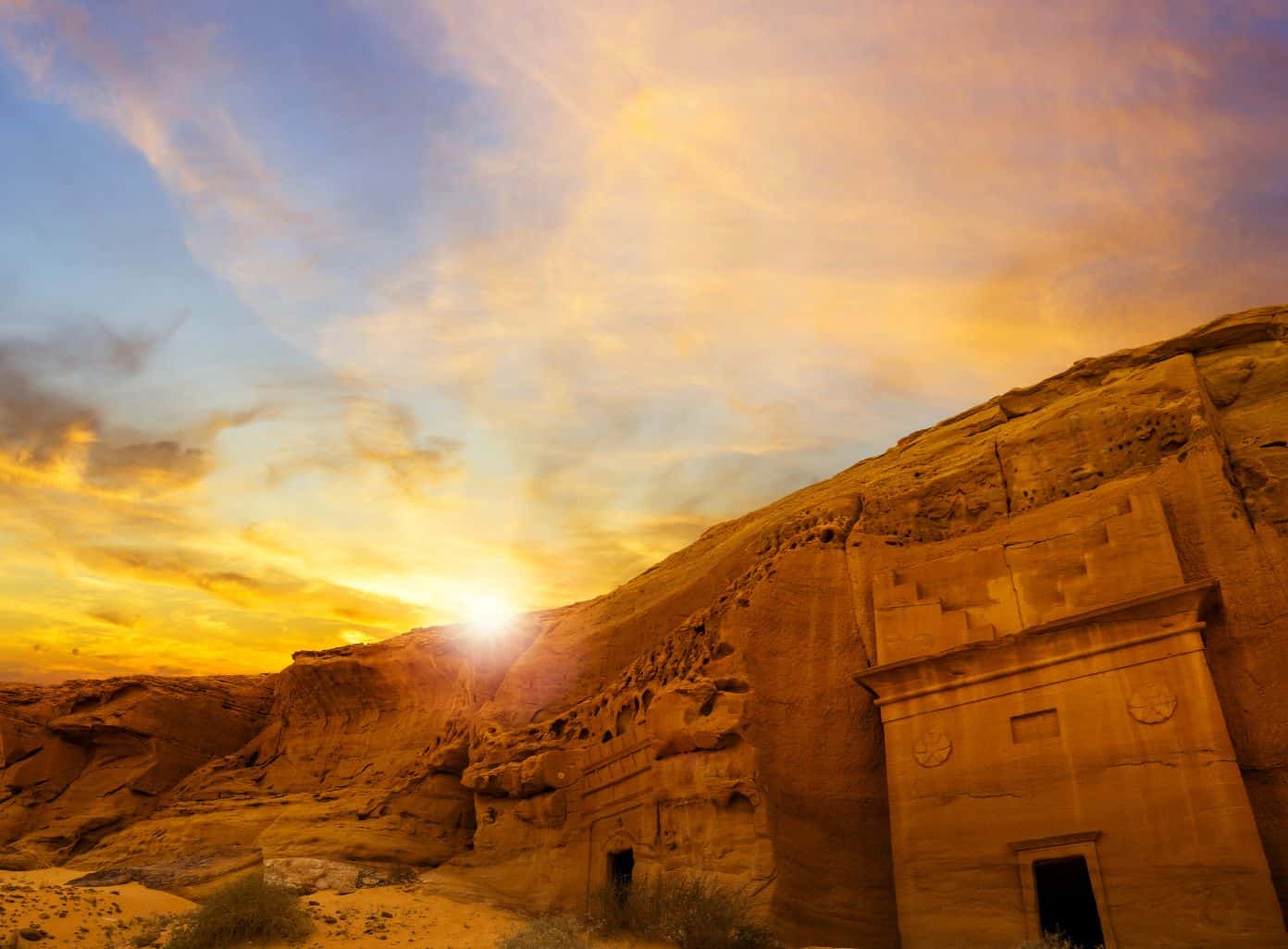Saudi Arabia: Uncovering Ancient Ruins
Saudi Arabia is a country with a rich history that dates back thousands of years. From ancient civilizations to significant trade routes, the region is home to a treasure trove of ancient ruins waiting to be discovered.

The Rich History of Saudi Arabia
Saudi Arabia’s history is deeply intertwined with the rise and fall of various empires and civilizations. It has been a crossroad for trade routes connecting the Middle East, Africa, and Asia, making it a melting pot of cultures and influences. The Arabian Peninsula was home to the ancient Nabateans, the powerful Kingdom of Saudi Arabia, and witnessed the birth of Islam. These historical events have left a lasting impact on the region and contribute to its diverse heritage.
The Forgotten Wonders: Ancient Ruins
Among the captivating attractions in Saudi Arabia are its ancient ruins, which offer a glimpse into the past and shed light on the achievements of these civilizations. Some of the notable ancient ruins include:
- Al-Hijr (Madain Salih): Also known as Madain Salih, this UNESCO World Heritage Site is an ancient Nabatean city that flourished more than 2,000 years ago. It is renowned for its well-preserved tombs and monumental rock-cut facades, showcasing the architectural brilliance of the Nabateans.
- Al-Ula: Located in the Al-Ula governorate, this site is home to ancient tombs, rock art, and archaeological remnants. The area showcases various civilizations that inhabited the region throughout history, including the Nabateans, Dedanites, and Lihyanites.
- Diriyah: As the original home of the Saudi royal family, Diriyah holds great historical significance. The site features ancient mud-brick structures, such as palaces, mosques, and traditional houses, providing a glimpse into the beginnings of the Saudi state.
Exploring these ancient ruins allows visitors to immerse themselves in the history and culture of Saudi Arabia. Witnessing the architectural marvels, intricate carvings, and ancient inscriptions offers a unique perspective on the region’s past.
As you plan your visit to Saudi Arabia, be sure to include these ancient ruins on your itinerary. They are a testament to the rich heritage of the country and offer a captivating journey through time.
Al-Hijr (Madain Salih)
History and Background
Al-Hijr, also known as Madain Salih, is an ancient archaeological site located in the northwestern part of Saudi Arabia. It was once inhabited by the Nabateans, an ancient Arab civilization that prospered during the first century AD. The site is renowned for its well-preserved tombs, monumental facades, and rock-cut structures, making it a UNESCO World Heritage Site.
Al-Hijr served as an important trading hub along the incense route, connecting southern Arabia with the Mediterranean world. It flourished economically and culturally, showcasing the architectural expertise and cultural diversity of the Nabateans. The site features inscriptions in a unique script, known as the Nabatean script, which provides valuable insights into the history and culture of the region.
Notable Features and Architecture
The architectural marvels of Al-Hijr are a testament to the advanced engineering skills of the Nabateans. The site is characterized by its rock-cut tombs and monumental facades, carved directly into the sandstone cliffs. These tombs served as burial chambers for the elite members of the Nabatean society.
One of the most iconic structures at Al-Hijr is the tomb of Qasr Al-Farid, also known as the “Lonely Castle.” This free-standing tomb is carved from a single rock and features intricate details, including ornamental motifs and inscriptions.
The site also includes the Diwan, a large open-air meeting hall, and the Nabatean well, which provided the community with a vital water source. These architectural marvels reflect the ingenuity and craftsmanship of the Nabateans, showcasing their ability to adapt to the harsh desert environment.
Exploring Al-Hijr allows visitors to step back in time and witness the magnificence of this ancient civilization. It is a remarkable destination for history enthusiasts and those interested in the rich cultural heritage of Saudi Arabia. To learn more about exploring historical sites in Saudi Arabia, check out our article on Saudi Arabia historical sites.
![]()
Al-Ula
History and Background
Al-Ula, located in the northwestern region of Saudi Arabia, is home to a mesmerizing collection of ancient ruins. This historically significant site dates back thousands of years and has witnessed the rise and fall of several civilizations. The history of Al-Ula can be traced back to the ancient Nabateans, who were known for their impressive architectural feats, including the famous city of Petra in neighboring Jordan.
Throughout its history, Al-Ula served as a vital crossroads for various trade routes, connecting Arabia with other regions. The ruins found in Al-Ula provide a glimpse into the rich cultural heritage of the people who once inhabited this area. From rock art and inscriptions to tombs and temples, Al-Ula’s ancient ruins are a testament to the ingenuity and creativity of past civilizations.
Notable Features and Architecture
Al-Ula boasts a remarkable array of architectural wonders that showcase the skills and craftsmanship of its ancient inhabitants. Some of the notable features include:
- Mada’in Saleh: Also known as Al-Hijr, Mada’in Saleh is a UNESCO World Heritage Site and the most iconic attraction in Al-Ula. It is home to around 130 tombs carved into the sandstone cliffs, showcasing intricate details and elaborate facades. These tombs were built by the Nabateans and served as burial chambers for their elite.
- Dadan: The ancient city of Dadan was once the capital of the Lihyanite civilization and boasts well-preserved ruins. Visitors can explore the remains of palaces, temples, and residential areas, gaining insights into the daily life of the people who lived here centuries ago.
- Elephant Rock: This natural rock formation is a popular sight in Al-Ula, resembling an elephant with its distinctive shape. The rock bears inscriptions and carvings that add to its historical significance.
- Al-Khuraybah: Located in the southern part of Al-Ula, Al-Khuraybah is an archaeological site with well-preserved tombs and dwellings carved into the sandstone cliffs. The site offers a glimpse into the ancient Nabatean civilization.
Al-Ula’s ancient ruins provide an extraordinary opportunity for visitors to immerse themselves in the rich history and cultural heritage of Saudi Arabia. Exploring these remarkable sites is an unforgettable experience that allows you to connect with the past and appreciate the architectural achievements of bygone civilizations.
Diriyah
History and Background
Diriyah, located just northwest of Riyadh, is a historically significant site in Saudi Arabia. It holds great cultural and historical importance as it was the first capital of the First Saudi State and the ancestral home of the ruling Al Saud family.
Founded in the 15th century, Diriyah played a vital role in the establishment of the modern Kingdom of Saudi Arabia. It served as the political and administrative center of the region and witnessed significant events in the country’s history, including the unification of Saudi tribes and the expansion of the Saudi dynasty.
Notable Features and Architecture
Diriyah boasts an impressive collection of ancient ruins and architectural marvels. The site is divided into several districts, each with its own unique features.
Turaif District is a UNESCO World Heritage Site and the most significant part of Diriyah. It is home to At-Turaif Palace, the seat of power for the ruling Al Saud family. The palace complex consists of several buildings, including royal residences, administrative offices, and mosques. The architecture showcases traditional Najdi style, characterized by mud-brick structures and intricate geometric patterns. Visitors can explore the restored buildings and gain insight into the lifestyle and governance of the early Saudi rulers.
Another notable feature of Diriyah is the Salwa Palace, located in the Ghusaybah District. This palace, built in the 18th century, served as the summer residence for the Saudi royal family. Its distinctive design features a blend of traditional and Ottoman architectural elements.
Additionally, the Saad ibn Saud Palace in the Salman ibn Muhammad District is worth visiting. This palace was built in the 19th century and showcases the development of architectural styles over time.
Exploring Diriyah’s ancient ruins allows visitors to immerse themselves in the rich history of Saudi Arabia. The site offers a glimpse into the past and a deeper understanding of the country’s cultural heritage.
To plan your visit to Diriyah and other historical sites in Saudi Arabia, it’s essential to consider factors such as opening hours, entry fees, and local resources. Guided tours are available to provide insightful commentary and enhance your experience. Remember to respect the cultural etiquette and follow respectful visiting practices when exploring these ancient ruins. For more information on Saudi Arabia’s historical sites and travel tips, check out our comprehensive Saudi Arabia travel guide.
By uncovering the wonders of Diriyah, visitors can gain a deeper appreciation for the historical significance of Saudi Arabia and the enduring legacy of the Al Saud dynasty.
How to Explore Saudi Arabia’s Ancient Ruins
When planning to explore the ancient ruins in Saudi Arabia, it’s important to consider certain factors to make your visit a memorable and enriching experience. Here are some essential aspects to keep in mind:
Planning Your Visit
Before embarking on your journey to explore Saudi Arabia’s ancient ruins, it’s crucial to conduct thorough research and plan your visit accordingly. Here are a few key points to consider:
- Opening Hours: Check the opening hours of the ancient ruins you plan to visit. Some sites may have specific visiting hours or days when they are closed to the public.
- Accessibility: Determine the accessibility of the ruins, including transportation options and nearby accommodation facilities. It’s advisable to choose accommodation in close proximity to the ruins to optimize your exploration time.
- Weather Conditions: Take into account the weather conditions during your visit. Saudi Arabia experiences extreme temperatures, so it’s essential to plan your trip during a season that offers comfortable weather for outdoor activities.
Guided Tours and Local Resources
To enhance your understanding of Saudi Arabia’s ancient ruins, consider joining guided tours or utilizing local resources. Here’s how you can make the most of these opportunities:
- Guided Tours: Engaging in guided tours can provide you with valuable insights into the historical and cultural significance of the ancient ruins. Knowledgeable guides can offer detailed explanations, highlighting key features and historical events associated with the sites. Look for reputable tour operators or guides who specialize in archaeological tours.
- Local Resources: Take advantage of local resources such as guidebooks, maps, and online platforms that provide information about the ancient ruins. These resources can offer valuable background knowledge, helping you navigate the sites and appreciate their significance.
Cultural Etiquette and Respectful Visiting Practices
While exploring Saudi Arabia’s ancient ruins, it’s important to be mindful of cultural etiquette and respectful visiting practices to ensure a harmonious experience. Here are some guidelines to follow:
- Dress Code: Dress modestly and respectfully, adhering to Saudi Arabia’s cultural norms. Both men and women should avoid wearing revealing or tight-fitting clothing. Women are required to cover their shoulders and knees, and it’s advisable to carry a headscarf for additional coverage when visiting religious or conservative sites.
- Photography: Before taking photographs, check for any restrictions or guidelines specific to each ancient ruin. Some sites may have restrictions on photography, especially in areas of religious or cultural significance. Always ask for permission from locals and respect their wishes.
- Behavior and Respect: Show respect for the ancient ruins by refraining from touching or removing any artifacts or structures. Follow any instructions provided by site officials or guides. Be mindful of the surroundings and avoid causing damage to the ruins or the natural environment.
By meticulously planning your visit, taking advantage of guided tours and local resources, and adhering to cultural etiquette, you can fully immerse yourself in the exploration of Saudi Arabia’s ancient ruins. The rich history and architectural marvels will undoubtedly leave you in awe of the country’s cultural heritage.


